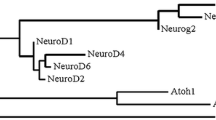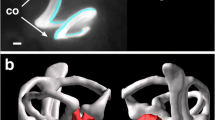Summary
The mechanosensory lateral-line system offers a unique opportunity to study a wide variety of developmental phenomena, including cell migration, the origin of polarity, and pattern formation. In this study, we use a series of transplantation experiments to examine some of the factors affecting the origin of the lateral-line placodes, the establishment of sensory organ polarity and placement, and the guidance of cell migration in the Mexican axolotl (Ambystoma mexicanum). We find that placode-forming ectoderm is at least partially specified as early as the beginning of neurulation, and we suggest that this may be a result of early processes involved in neural induction. Furthermore, we find that the migration of the primordia on the body depends on the presence of both the ectoderm and the subjacent mesoderm for guidance. Sensory organ polarity on the body appears to be the result of an interaction between the primordia, which deposit organs of set polarity relative to the direction of migration, and the substrate, which determines the direction of migration. Spacing of the organs is independent of the substrate, and may be due to an intrinsic property of either the primordia or the emerging organs themselves. Finally, we suggest that the lateral-line primordia are guided, as they migrate, by a contact guidance mechanism.
Similar content being viewed by others
References
Albers B (1987) Competence as the main factor determining the size of the neural plate. Dev Growth Differ 29:535–545
Armstrong JB (1989) Morphogenetic waves during elongation. In: Armstrong JB, Malacinski GM (eds) Developmental Biology of the Axolotl. Oxford University Press, Oxford, pp 72–82
Armstrong JB, Graveson AC (1988) Progressive patterning precedes somite segmentation in the Mexican axolotl (Ambystoma mexicanum). Dev Biol 126:1–6
Asashima M, Malacinski GM, Smith SC (1989) Surgical manipulation of embryos. In: Armstrong JB, Malacinski GM (eds) Developmental Biology of the Axolotl. Oxford University Press, Oxford, pp 255–263
Blaxter JHS (1987) Structure and development of the lateral line. Biol Rev Cambridge Philos Soc 63:471–514
Bordzilovskaya NP, Dettlaff TA (1979) Table of stages of the normal development of axolotl embryos and the prognostication of timing of successive developmental stages at various temperatures. Axolotl Newslett 7:2–22
Bordzilovskaya NP, Dettlaff TA, Duhon ST, Malacinski GM (1989) Developmental stage series of axolotl embryos. In: Armstrong JB, Malacinski GM (eds) Developmental Biology of the Axolotl. Oxford University Press, Oxford, pp 201–219
Carter SB (1967) Haptotaxis and the mechanism of cell motility. Nature 213:256–260
Coombs S, Janssen I, Webb JF (1988) Diversity of lateral line systems: Evolutionary and functional considerations. In: Atema J, Fay RR, Popper AN, Tavolga WN (eds) Sensory Biology of Aquatic Animals. Springer, Berlin, pp 553–594
Coombs S, Görner P, Münz H (eds) (1989) The Mechanosensory Lateral Line. Springer, Berlin Heidelberg New York
Cooper MS, Keller RE (1984) Perpendicular orientation and directional migration of amphibian neural crest cells in DC electrical fields. Proc Natl Acad Sci USA 81:160–164
Detwiler SR (1934) An experimental study of spinal nerve segmentation in Amblystoma with reference to the plurisegmental contribution to the brachial plexus. J Exp Zool 67:395–441
Dijkgraaf S (1963) The functioning and significance of the lateralline organs. Biol Rev 38:51–105
Dunn GA (1982) Contact guidance of cultured tissue cells: A survey of potentially relevant properties of the substratum. In: Bellairs R, Curtis A, Dunn GA (eds) Cell Behaviour. Cambridge University Press, Cambridge, pp 247–280
Ebendal T (1977) Extracellular matrix fibrils and cell contacts in the chick embryo. Possible roles in orientation of cell migration and axon extension. Cell Tissue Res 175:439–458
Erickson CA (1985a) Morphogenesis of the neural crest. In: Browder L (ed) Developmental Biology: A Comprehensive Synthesis. Cellular Basis of Morphogenesis. Plenum Press, New York
Erickson CA (1985b) Control of neural crest cell dispersion in the trunk of the avian embryo. Dev Biol 111:138–157
Flock A (1965) Electron microscopic and physiologic studies on the lateral line canal organ. Acta Otolaryngol [Suppl] 199:1–90
Gans C, Northcutt RG (1983) Neural crest and the origin of vertebrates: A new head. Science 220:268–274
Gillespie LL, Armstrong JB (1986) Morphogenetic waves in the development of the lateral mesoderm in the Mexican axolotl (Ambystoma mexicanum) and their relationship to pronephric duct migration. J Exp Zool 237:327–338
Görner P, Mohr C (1989) Stimulus localization in Xenopus: Role of directional sensitivity of lateral line stitches. In: Coombs S, Görner P, Münz H (eds) The Mechanosensory Lateral Line: Neurobiology and Evolution. Springer, Berlin, pp 543–560
Harrison RG (1904) Experimentelle Untersuchungen über die Entwicklung der Sinnesorgane der Seitenlinie bei den Amphibien. Arch Mikrosk Anat Entwicklungmech 63:35–149
Hörstadius S (1950) The Neural Crest: Its Properties and Derivatives in the Light of Experimental Research. Oxford Univ Press, Oxford
Landacre FL (1921) The fate of the neural crest in the head of the urodeles. J Comp Neurol 33:1–43
Landacre FL (1928) The differentiation of the preauditory and postauditory primitive lines into preauditory and postauditory placodes, lateralis ganglia and migratory lateral-line placodes in Amblystoma jeffersonianum. J Comp Neurol 44:29–58
Lannoo MJ (1987a) Neuromast topography in anuran amphibians. J Morphol 191:115–129
Lannoo MJ (1987b) Neuromast topography in urodele amphibians. J Morphol 191:247–263
Lannoo MJ, Smith SC (1989) The lateral line system. In: Armstrong JB, Malacinski GM (eds) Developmental Biology of the Axolotl. Oxford University Press, Oxford, pp 176–186
Letourneau PC (1975) Cell-to-substratum adhesion and guidance of axonal elongation. Dev Biol 44:92–101
Löfberg J, Ahlfors K, Fallstrom C (1980) Neural crest cell migration in relation to extracellular matrix organization in the embryonic axolotl trunk. Dev Biol 75:148–167
Löfberg J, Epperlein HH, Perris R, Stigson M (1989) Neural crest cell migration: A pictorial essay. In: Armstrong JB, Malacinski GM (eds) Developmental Biology of the Axolotl. Oxford Univ Press, Oxford, pp 83–101
Metcalfe WK (1985) Sensory neuron growth cones comigrate with posterior lateral line primordial cells in zebrafish. J Comp Neurol 238:218–224
Newgreen DF (1989) Physical influences on neural crest cell migration in avian embryos: Contact guidance and spatial restriction. Dev Biol 131:136–148
Northcutt RG, Gans C (1983) The genesis of neural crest and epidermal placodes: A reinterpretation of vertebrate origins. Q Rev Biol 58:1–28
Poole TJ, Steinberg MS (1982) Evidence for the guidance of pronephric duct migration by a craniocaudally travelling adhesion gradient. Dev Biol 92:144–158
Russell IJ (1976) Amphibian lateral line receptors. In: Llinas R, Precht W (eds) Frog Neurobiology, A Handbook. Springer, Berlin, pp 513–550
Sand O (1984) In: Bolis L, Keynes RD, Maddrell SHP (eds) Comparative Physiology of Sensory Systems. Cambridge University Press, Cambridge, pp 3–32
Shelton PMJ (1971) The structure and function of the lateral line system in larval Xenopus laevis. J Exp Zool 178:211–231
Smith SC, Lannoo MJ, Armstrong JB (1988) Lateral-line neuromast development in Ambystoma mexicanum and a comparison with Rana pipiens. J Morphol 198:367–379
Steinberg MS (1970) Does differential adhesion govern self-assembly process in histogenesis? Equilibrium configurations and the emergence of a hierarchy among populations of embryonic cells. J Exp Zool 173:395–434
Stone LS (1922) Experiments on the development of the lateral line sense organs in Amblystoma punctatum. J Exp Zool 35:421–496
Stone LS (1928a) Experiments on the transplantation of placodes of the cranial ganglia in the amphibian embryo. II. Heterotopic transplantation of the ophthalmic placode upon the head and body of Amblystoma punctatum. J Comp Neurol 45:169–190
Stone LS (1928b) Experiments on the transplantation of placodes of the cranial ganglia in the amphibian embryo. III. Preauditory and postauditory placodal materials interchanged. J Comp Neurol 47:117–154
Stone LS (1929) Experiments on the transplantation of placodes of the cranial ganglia in the amphibian embryo. IV. Heterotopic transplantations of the postauditory placodal material upon the head and body of Amblystoma punctatum. J Comp Neurol 48:311–330
Stone LS (1933) Development of the lateral-line sense organs in amphibians observed in living and vitally stained preparations. J Comp Neurol 57:507–540
Stone LS (1938) Further experimental studies of the development of lateral-line sense organs in amphibians observed in living preparations. J Comp Neurol 68:83–115
Thiery JP, Boucaut JC, Duband JL, Poole TJ, Aoyama H, Yamada KM (1984) Mechanisms of embryonic cell migration in the vertebrate embryo. J Cell Biol 99:235a
Trinkaus JP (1976) On the mechanism of metazoan cell movements. In: Poste G, Nicolson GL (eds) The Cell Surface in Animal Embryogenesis and Development. Biomed Press, Elsevier, North Holland, pp 225–329
Trinkaus JP (1982) Some thoughts on directional cell movement during morphogenesis. In: Bellairs R, Curtis A, Dunn GA (eds) Cell Behaviour. Cambridge Univ Press, Cambridge, pp 471–498
Trinkaus JP (1984) Cells Into Organs, second ed, Prentiss-Hall, Englewood Cliffs, New Jersey
Vanable JW, Jr (1985) Benzocaine: An excellent amphibian anesthetic. Axolotl Newslett 14:19–21
Webb JF (1989) Gross morphology and evolution of the mechanoreceptive lateral-line system in teleost fishes. Brain Behav Evol 33:34–53
Weiss P (1947) The problem of specificity in growth and development. Yale J Biol Med 19:235–278
Weiss P (1961) Ruling principles in cell locomotion and cell aggregation. Exp Cell Res [Suppl] 8:260–281
Winklbauer R, Hausen P (1983a) Development of the lateral line system in Xenopus laevis I. Normal development and cell movement in the supraorbital system. JEEM 76:265–281
Winklbauer R, Hausen P (1983b) Development of the lateral line system in Xenopus laevis. II. Cell multiplication and organ formation in the supraorbital system. JEEM 76:283–296
Winklbauer R, Hausen P (1985a) Development of the lateral line system in Xenopus laevis. III. Development of the supraorbital system in triploid embryos and larvae. JEEM 88:183–192
Winklbauer R, Hausen P (1985b) Development of the lateral line system in Xenopus laevis. IV. Pattern formation in the supraorbital system. JEEM 88:193–207
Wright MR (1951) The lateral line system of sense organs. Q Rev Biol 26:264–280
Zackson SL, Steinberg MS (1986) Cranial neural crest cells exhibit directed migration on the pronephric duct pathway: Further evidence for an in vivo adhesion gradient. Dev Biol 117:342–353
Author information
Authors and Affiliations
Rights and permissions
About this article
Cite this article
Smith, S.C., Lannoo, M.J. & Armstrong, J.B. Development of the mechanoreceptive lateral-line system in the axolotl: placode specification, guidance of migration, and the origin of neuromast polarity. Anat Embryol 182, 171–180 (1990). https://doi.org/10.1007/BF00174016
Accepted:
Issue Date:
DOI: https://doi.org/10.1007/BF00174016




